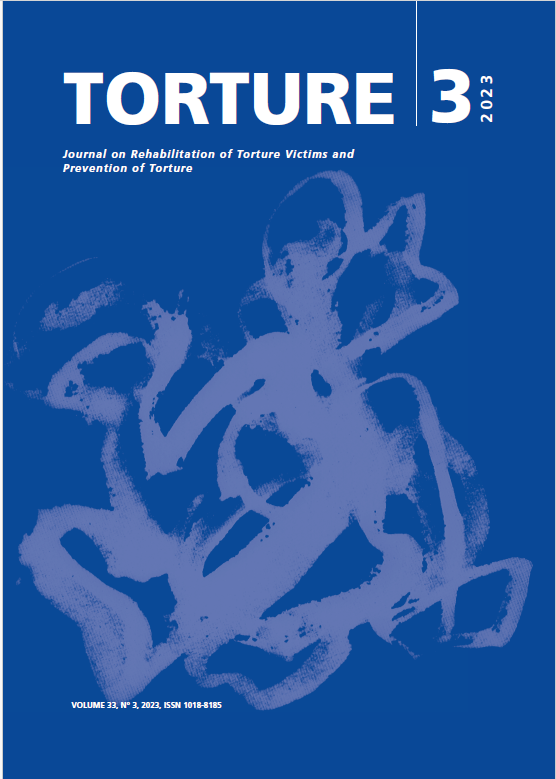Introducing the International Guiding Statement on alternatives to solitary confinement
DOI:
https://doi.org/10.7146/torture.v33i3.141379Palabras clave:
solitary confinement, human rights, prisonResumen
Based on the reflections of a multidisciplinary group of experts, Physicians for Human Rights Israel and Antigone worked on the International Guiding Statement on Alternatives to Solitary Confinement, proposing global guidelines for reducing and finally overcoming the use of solitary confinement in prisons
Citas
Austin, J., & Irwin, J., (2001), It’s about time: America’s Imprisonment Binge, Belmont, Wadsworth. Brasholt, M., Sveaass, N., Pérez Sales, P., Marboeuf, H., Cakal, E., & Søndergaard, E., (2023), Protocol on medico-legal documentation of solitary confinement, Torture Journal, 33(1), pp. 92–118, https://doi.org/10.7146/torture. v33i1.130739 (consulted on 03.10.23). Brioschi, F., & Paterniti Martello, C., (2021), Monitoring Solitary Confinement in Prison. A Handbook for National Preventive Mechanisms, Associazione Antigone, https://www.antigone.it/ upload2/uploads/docs/handbook_-_monitoring_ solitary_confinement_in_prison.pdf (consulted on 03.10.23). Consensus Statement from the Santa Cruz Summit on Solitary Confinement and Health, (2020), Northwestern University Law Review, 115(335), https://scholarlycommons.law.northwestern.edu/ nulr/vol115/iss1/9 (consulted on 03.10.23). De Beaumont, G., & De Tocqueville, A., (1833), On the Penitentiary Systemin the United States and Its Application in France, Philadelphia: Carey Lea and Blanchard, http://davidmhart. com/liberty/FrenchClassicalLiberals/Beaumont/ Beaumont_1833PenitentiarySystem.pdf (consulted on 02.10.23).
De La Rochefoucauld-Liancourt (1796), Des prisons de Philadelphie, par un Européen, Paris: Du Pont. Haney, C., (2017), The dimensions of suffering in solitary confinement, Law and Neuroscience Conference 2017. A question of fit: translating Neuroscience for Law, Clinical Care and Policy, UCSF/UC Hastings Consortium on Law, Science and Health Policy, California, 16-17 of february 2017. Haney, C., (2003), Mental Health Issues in LongTerm Solitary and “Supermax” Confinement, Crime & Delinquency, 49(1), pp. 124–156, https:// doi.org/10.1177/0011128702239239 (consulted on 03.10.23). Howard, J., (1777), The State of the Prisons in England and Wales, with preliminary observations and an account of some foreign prisons. London: William Eyres. Kaba, F., Lewis, A., Glowa-Kollisch, S., Hadler, J., Lee, D., Alper, H., Selling, D., MacDonald, R., Solimo, A., Parsons, A., Venters, H. (2014, March), Solitary Confinement and Risk of Selfharm Among Jail Inmates, American Journal of Public Health, 104(3), pp. 442-447, https://www. ncbi.nlm.nih.gov/pubmed/24521238 (consulted on 03.10.23). King, K., Steiner, B., Breach, S., (2008), Violence in the supermax: self-fulfilling prophecy. Prison Journal, 88(1), pp. 144-168. Kupers, T., (2015), A Community Mental Health Model in Corrections, Stanford Law & Policy Review, 26 (119). Kupers, T., (2016). The SHU Post-Release Syndrome, Correctional Mental Health Report, 17(6), pp. 81-96. Kupers, T., (2017), Solitary: The Inside Story of Solitary Confinement and How We Can Abolish It, Berkeley: University of California Press. Lobel J. & Smith P. S. (2019), Solitary Confinement: Effects, Practices and Pathways toward Reform, Oxford Scolarship Online (ebook). Mears, D., P., & Reisig, M., D., (2006), The theory and practice of supermax prisons, Punishment and Society, 8 (1), pp. 33-57. Mears, D., P., Brown, J., M., Cochran, J., C., Siennick, E., (2021a), Extended Solitary Confinement for Managing Prison Systems: Placement Disparities and Their Implications, Justice Quarterly, 38 (7), pp. 1492-1518. Mears, D., P., Aranda-Hughes, V., Pesta, G., B., (2021b), Managing Prisons Through Extended Solitary Confinement: A Necessary Approach or a Signal of Prison System Failure? International Journal of Offender Therapy and Comparative Criminology, 0(0), pp. 1-23. Pizzarro, J., & Stenius, V., (2004), Supermax Prisons: Their Rise, Current Practice, and Effects on Inmates, Prison Journal, 84 (2), pp. 248-264. Rhodes, L., A., 2004. Total confinement. Madness and reason in the maximum security prison, Berkley and Los Angeles: University of California Press. Riveland, C., (1999), Supermax Prisons: Overview and General Considerations, Washington DC, US Departament of Justice, National Institute of Corrections. Shalev, S., (2008), A sourcebook on solitary confinement, London, Mannheim Centre for Criminology, London School of Economics. Shalev, S., (2009), Supermax. Controlling risk through solitary confinement, Portland, Willian Publishing. Smith, P., S., (2006), The Effects of Solitary Confinement on Prison Inmates: A Brief History and Review of the Literature, Crime and Justice, 34(1), pp. 441–528, https://doi. org/10.1086/500626 (consulted on 03.10.23). Solitary Watch & The Unlock Box Campaign (2023), Calculating Torture, https://solitarywatch.org/ calculating-torture/ (consulted on 03.10.2023). Strong, J., K. Reiter, D. Augustine, M. Barragan, K. Chesnut, P. Dashtgard, G. Gonzalez, N. Pifer, and R. Tublitz (2020), The Body in Isolation: The Physical Health Impacts of Incarceration in Solitary Confinement, PLOS ONE, 15(10). Stroppa, R., (2022), Genealogía, Legalidad y Realidad del aislamiento penitenciario. El caso de Catalunya, Tesis Doctoral, Universitat de Barcelona. Toch, H., (1992), Mosaic of Despair: Human Breakdown in Prison, Washington D. C., American Psychological Association. World Medical Association, (2019), Statement on Solitary Confinement, adopted by the 65th WMA General Assembly, Durban, South Africa, October 2014 and revised by the 70th WMA General Assembly, Tbilisi, Georgia, October 2019, https://www.wma.net/policies-post/wmastatement-on-solitaryconfinement/ (consulted on 03.10.23).
Descargas
Publicado
Cómo citar
Número
Sección
Licencia
Derechos de autor 2023 Torture Journal

Esta obra está bajo una licencia internacional Creative Commons Atribución-NoComercial-SinDerivadas 4.0.
We accept that some authors (e.g. government employees in some countries) are unable to transfer copyright. The Creative Commons Licence Attribution-NonCommercial-NoDerivatives 4.0 International (CC BY-NC-ND 4.0) covers both the Torture Journal and the IRCT web site. The publisher will not put any limitation on the personal freedom of the author to use material contained in the paper in other works which may be published, provided that acknowledgement is made to the original place of publication.


